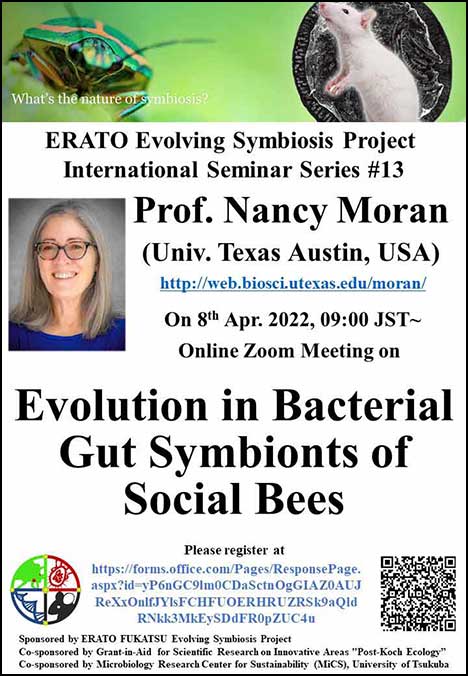第13回共生進化機構国際セミナーをオンライン開催しました。
昆虫―微生物共生に関する広範な研究で著名なProf. Nancy Moran(University of Texas at Austin, USA)にご講演いただきました。

Abstract:Social lifestyles open the door to specialized microbial symbionts that can use host interactions for direct host-to-host transmission; examples are found in gut microbiomes of mammals and some social insects. Host-restricted gut communities are often characterized by high levels of strain diversification, both within and between hosts. Among these groups, social bees, including honey bees, bumble bees, and stingless bees, form a remarkable and diverse clade, characterized by colonial living whereby sterile female workers forage and rear larvae. Social bees are distinguished by characteristic and (relatively) simple bacterial gut communities that are socially transmitted. Some of the constituent bacterial lineages have evolved with social bees since the origin of the clade, over 80 million years ago. In Apis mellifera (western honey bee), these bacteria have been shown to perform many beneficial functions for hosts, involving
nutrition and protection from pathogens. All of these bee gut bacterial species can be cultured axenically; at least some can be genetically engineered, and experiments with gnotobiotic hosts are possible.
In this talk, I present some recent work on evolutionary diversification of the bee gut microbiota, including species formation and extinction in particular host lineages. Diversification requires barriers to homologous recombination of bacterial strains, which can occur when hosts speciate, when symbionts jump to novel host species, or when bacteria adopt distinct, spatially separated ecological niches within a single host. In the latter case, horizontally acquired genes may enable novel metabolism and ecological shifts, potentially confining populations to different gut regions and thus limiting exchange of DNA. All of these processes coincide in the social bee microbiota. Additionally, in some cases, bee host lineages have completely lost particular ancestral symbiont lineages. Finally, other insects using the same flower-associated resources, appear sometimes to have acquired symbionts from social bees.
ERATO Evolving Symbiosis Project International Seminar Series #13
第13回共生進化機構国際セミナー
Sponsored by ERATO FUKATSU Evolving Symbiosis Project
主催:ERATO深津共生進化機構プロジェクト
https://www.jst.go.jp/erato/fukatsu/
Co-sponsored by Grant-in-Aid for Scientific Research on Innovative Areas "Post-Koch Ecology”
共催:新学術領域研究「ポストコッホ生態」
https://postkoch.jp/about/
Co-sponsored by Microbiology Research Center for Sustainability (MiCS), University of Tsukuba
共催:筑波大学微生物サステイナビリティ研究センター(MiCS)
https://www.mics.tsukuba.ac.jp/


